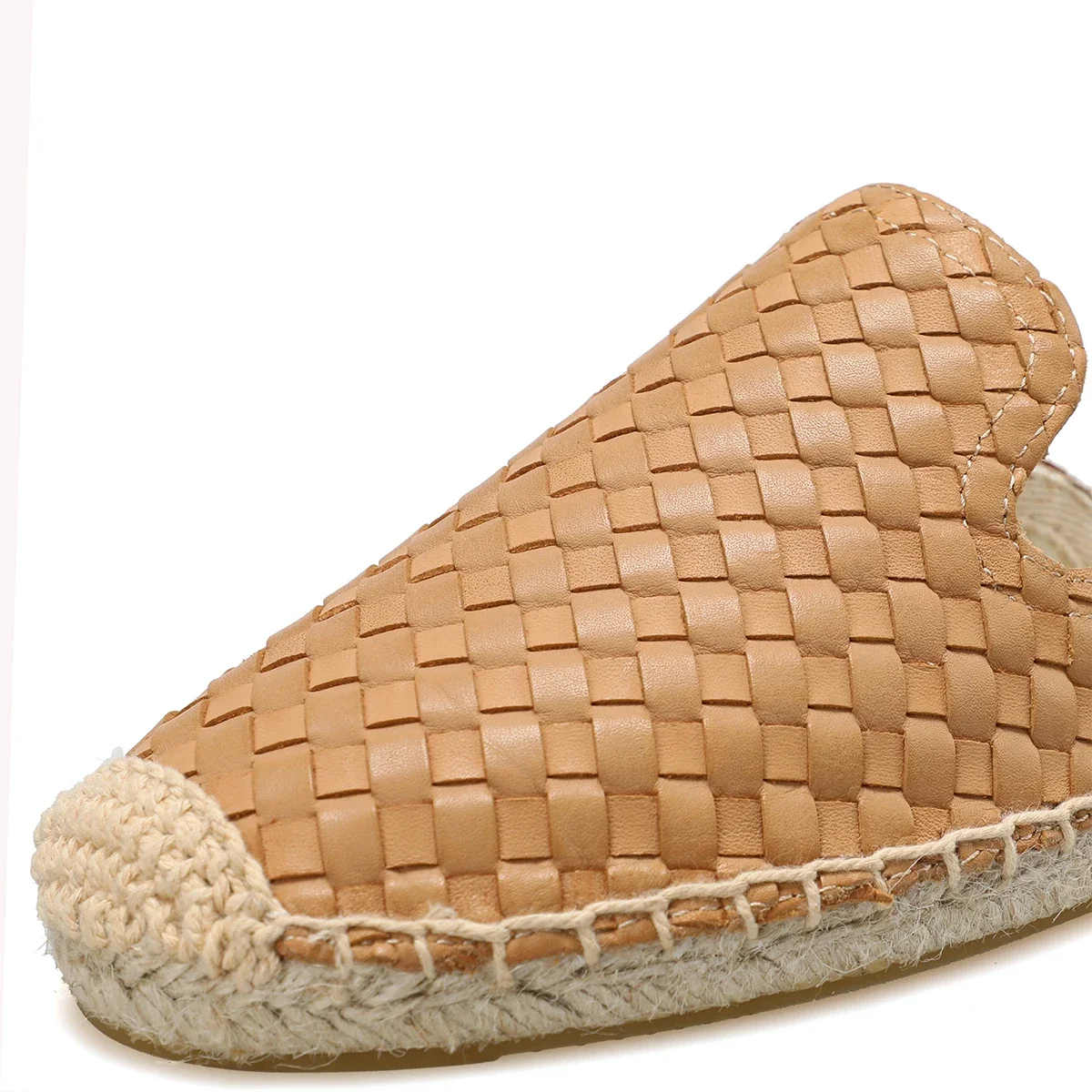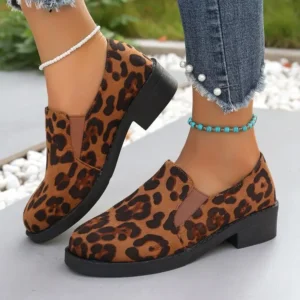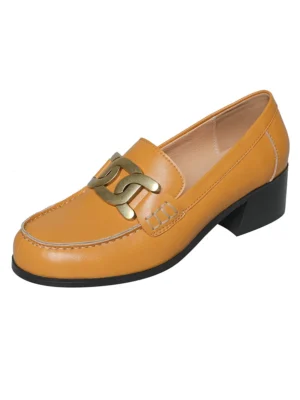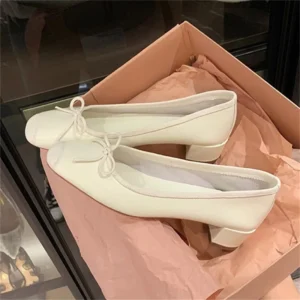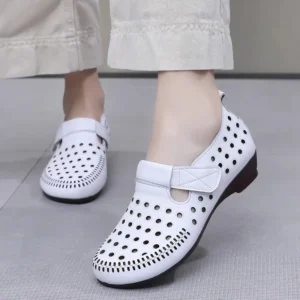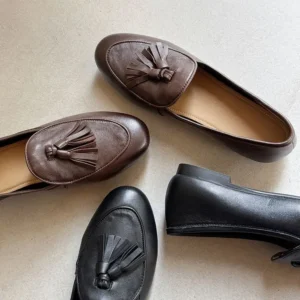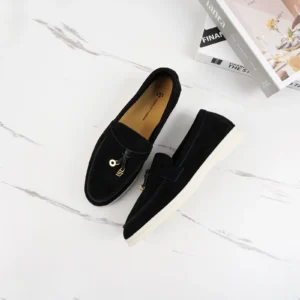The Evolution of Loafers: From Classic to Contemporary
Loafers have carved out their place as one of the most adaptable footwear options in modern fashion. These slip-on shoes have evolved remarkably over decades, transforming from purely functional footwear to versatile fashion statements that complement countless outfits and occasions.
Today, the loafer family has branched into two distinct categories that shoppers often consider: the traditional full-back loafer and its contemporary cousin, the open-back loafer. While both maintain the signature loafer front design—with their characteristic vamp and often decorative elements—they differ significantly in their back construction and, consequently, their feel, function, and fashion potential.
This evolution reflects broader changes in how we approach fashion—balancing timeless appeal with modern convenience. With nearly 70% of women now owning at least one pair of loafers, understanding the differences between these styles becomes increasingly important for making informed wardrobe choices.
The question many fashion-conscious individuals face is straightforward yet significant: which loafer style better aligns with your lifestyle, comfort needs, and personal aesthetic? Whether you’re building a professional wardrobe for professional office loafer outfits or seeking versatile weekend footwear, the choice between traditional and open-back designs impacts both comfort and style.
In this comprehensive comparison, we’ll explore every aspect of these two loafer styles to help you determine which deserves a place in your shoe collection—or whether both might serve different purposes in a well-rounded wardrobe.
Understanding Traditional Loafers: The Timeless Classic
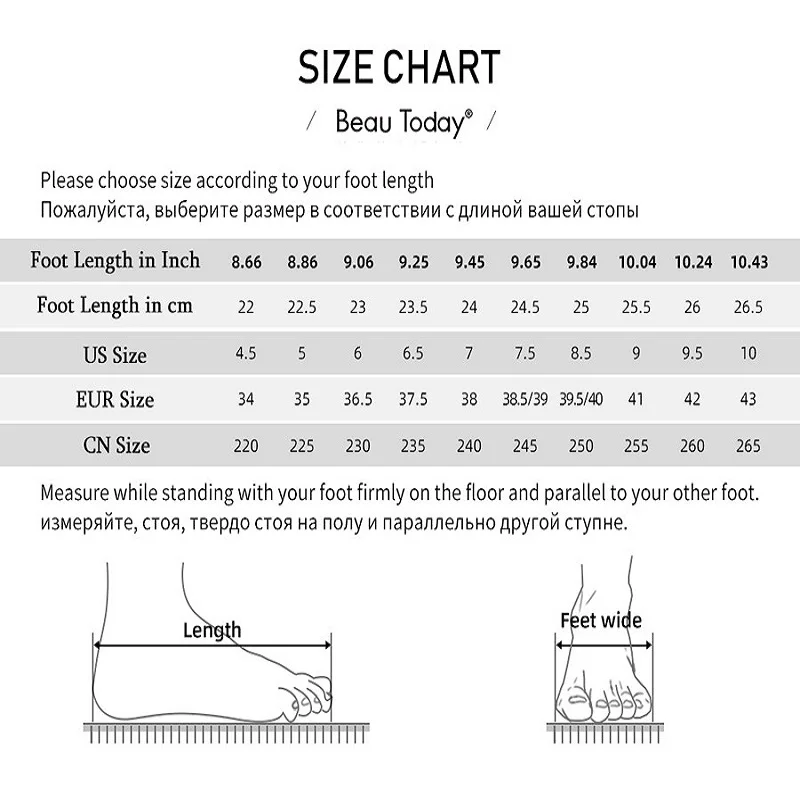
Traditional loafers represent the original design that has stood the test of time since their introduction to mainstream fashion. These slip-on shoes feature a full, enclosed design that completely surrounds the foot, including the heel. The defining characteristic of traditional loafers is their structured build that offers both support and a polished appearance.
Key Design Elements
Traditional loafers come in several classic variations, each with distinctive features:
- Penny loafers: Featuring a leather strap across the vamp with a diamond-shaped slot originally designed to hold a coin
- Tassel loafers: Adorned with decorative tassels at the vamp
- Horsebit loafers: Distinguished by a metal horse-bit detail across the vamp
- Moccasin construction: Many traditional loafers feature hand-sewn moccasin-style stitching around the toe
These shoes are typically crafted from premium materials, with genuine leather being the most common and respected choice. High-quality suede, patent leather, and exotic leathers also feature prominently in luxury versions. The construction methods employed—including Goodyear welting, Blake stitching, or Bologna construction—provide structure, support, and longevity that have made traditional loafers enduring favorites.
What distinguishes traditional loafers is their heritage and staying power. They’ve maintained their place in fashion for generations, becoming staples in both professional and casual wardrobes. Their enclosed design provides security and stability while walking, making them practical for all-day wear in various settings.
Learning how to wear loafers to the office can elevate your professional wardrobe significantly. These versatile shoes transition seamlessly from boardroom meetings to after-work gatherings without sacrificing comfort or style.
For those seeking variety within this classic category, our collection of women’s flat classic loafers showcases the breadth of options available, from minimalist designs to those with distinctive decorative elements. The traditional loafer remains a foundation piece that transcends passing trends while still allowing for personal expression.
Understanding Open-Back Loafers: The Modern Alternative
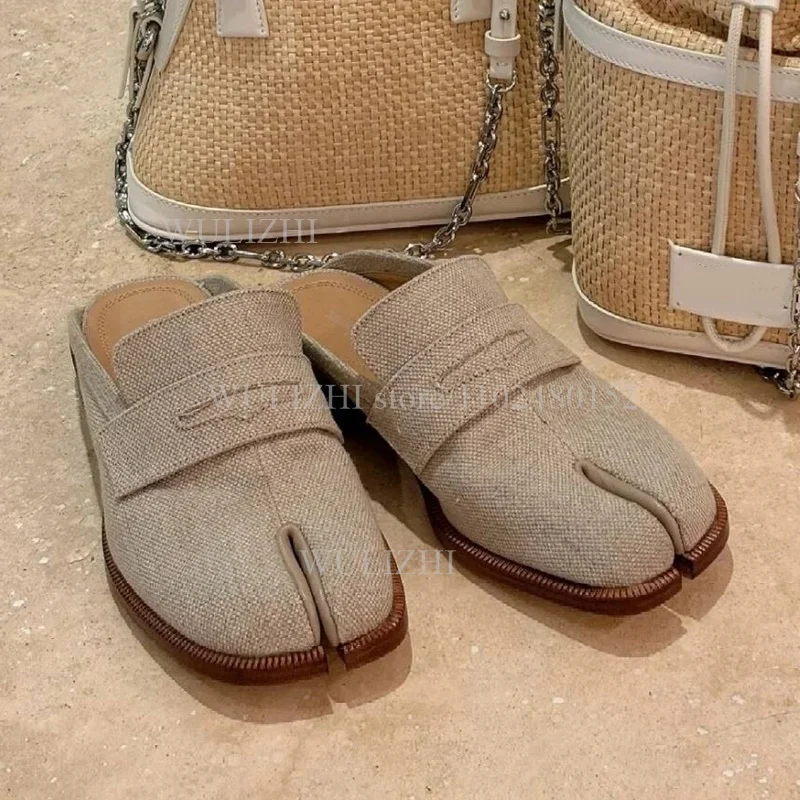
Open-back loafers, often called loafer mules, represent a contemporary take on the classic design. These shoes maintain the traditional loafer front—complete with the characteristic vamp and often decorative elements like penny slots or tassels—but feature an exposed heel area that sets them apart from their conventional counterparts.
This modern interpretation has gained significant popularity in recent years as fashion increasingly embraces designs that combine classic elements with fresh approaches. Open-back loafers offer the refined appearance of traditional loafers at the front while introducing a more relaxed, casual element with their exposed heel.
Key Design Elements
Open-back loafers maintain several classic loafer features while introducing unique characteristics:
- Exposed heel: The defining feature that allows easy slip-on access
- Front design continuity: Maintains traditional loafer elements like penny slots, tassels, or horsebits
- Slightly modified vamp: Often designed to hold the foot more securely without back support
- Varied heel heights: From completely flat to modest block heels for added stability
Material choices for open-back loafers often prioritize flexibility and softness, as these qualities enhance the slip-on nature of the design. While leather remains popular, softer, more pliable varieties are often selected to improve comfort and reduce break-in time. Some designs feature specialized footbeds with extra cushioning to compensate for the reduced structure.
The open-back construction presents unique challenges for manufacturers, requiring thoughtful design to ensure the shoes stay securely on the foot without a back to hold the heel in place. This has led to innovations like slightly narrower fits, strategic cushioning, and textured insoles that help the foot maintain contact with the shoe while walking.
Our women’s loafer mules collection showcases the versatility within this modern category. For those seeking slightly more security while maintaining the open-back aesthetic, women’s mule slingback loafers offer an excellent compromise with an added strap that enhances stability.
The open-back loafer represents fashion’s evolution—honoring traditional design elements while adapting to contemporary preferences for convenience and casual sophistication.
Comparative Analysis: Design and Structure
When comparing traditional and open-back loafers, the most obvious difference lies in their structural design—specifically, how they interact with the back of the foot. This fundamental distinction influences everything from their visual impact to their functionality.
Physical Structure Comparison
| Feature | Traditional Loafers | Open-Back Loafers |
|---|---|---|
| Heel Coverage | Complete enclosure | Exposed heel |
| Foot Security | High – surrounds entire foot | Moderate – relies on front fit |
| Weight | Generally heavier | Typically lighter |
| Visual Profile | More structured, formal appearance | Relaxed, casual silhouette |
| Foot Visibility | Minimal – covers most of the foot | Increased – exposes heel and ankle |
Traditional loafers present a more complete, structured silhouette that creates a solid visual foundation for outfits. Their full enclosure provides a clean line from toe to heel, contributing to their more formal appearance. The weight and substance of traditional loafers also convey a sense of quality and permanence that aligns with their heritage status.
In contrast, open-back loafers create a lighter visual impression with their exposed heel area. This design creates a different proportion that can elongate the appearance of the leg, particularly when paired with cropped pants or skirts. The negative space created by the open back introduces a more casual, relaxed element to the overall aesthetic.
From a design perspective, traditional loafers often include more detailed craftsmanship throughout the entire shoe, while open-back versions may concentrate visual interest on the front portion. This focus can actually highlight decorative elements like tassels or metal bits, drawing more attention to these signature features.
Those looking to incorporate loafers into their everyday style might consider how traditional leather loafer outfits can be built around the more structured appearance these shoes provide. The visual weight and complete silhouette of traditional designs often pair particularly well with tailored clothing and more formal ensembles.
The structural differences between these styles extend beyond aesthetics to significantly impact comfort and wearability—a crucial consideration for any footwear purchase.
Comparative Analysis: Comfort and Wearability
The structural differences between traditional and open-back loafers directly impact how these shoes feel during wear. Understanding these comfort distinctions helps determine which style better suits your daily needs and foot sensitivities.
Fit Security and Stability
Traditional loafers provide superior stability through their enclosed design. The heel counter (the structured back portion) prevents the foot from sliding forward and offers lateral stability during walking. This comprehensive support distributes pressure more evenly across the foot, potentially reducing fatigue during extended wear.
Open-back loafers, lacking this rear support structure, require a different wearing technique. Many wearers naturally grip slightly with their toes to keep the shoe in place—a subconscious action that can lead to toe fatigue or strain during extended wear periods. However, this same characteristic makes them extraordinarily easy to slip on and off, perfect for quick errands or casual settings.
Breathability and Temperature Regulation
One significant advantage of open-back designs is enhanced air circulation. The exposed heel allows for considerably better ventilation, making open-back loafers excellent warm-weather options. This design significantly reduces foot perspiration and the associated discomfort.
Traditional loafers provide more comprehensive protection in cooler weather and can be paired with socks for additional warmth without compromising the look. However, their enclosed design can lead to increased heat and moisture retention, particularly in warmer conditions or for those prone to foot perspiration.
Adaptation to Foot Shapes
Both styles accommodate different foot shapes in distinct ways:
- Traditional loafers, particularly quality leather versions, mold to the entire foot over time, creating a custom fit that includes heel support.
- Open-back loafers need to fit perfectly in the front portion from the start, as there’s no back adjustment possible. This makes initial fit particularly important.
For those prioritizing all-day comfort and support, our women’s comfortable flat loafers collection features traditional designs with enhanced comfort features like padded insoles and flexible construction.
The comfort trade-offs between these styles highlight how personal preferences and specific use cases should guide your selection. Someone who stands for extended periods might benefit from the comprehensive support of traditional loafers, while someone prioritizing breathability and convenience might prefer the open-back design.
Comparative Analysis: Versatility and Occasion Appropriateness
The distinct designs of traditional and open-back loafers naturally lend themselves to different settings and occasions. Understanding where each style shines helps determine which better complements your lifestyle and wardrobe needs.
Traditional Loafers: Formality Range
Traditional loafers possess remarkable versatility across formality levels:
- Business Settings: Leather penny or horsebit loafers in darker colors like black, burgundy, or navy pair seamlessly with suits and business attire
- Smart Casual Environments: Work exceptionally well with chinos, tailored pants, and blazer combinations
- Casual Outings: Can be dressed down with jeans and casual tops, particularly in more relaxed materials like suede
This impressive range makes traditional loafers true wardrobe workhorses. They transition effortlessly between morning meetings and evening gatherings, making them excellent travel companions and go-to footwear for busy professionals.
For those navigating professional environments, exploring business casual loafer outfit ideas can provide inspiration for incorporating these versatile shoes into workplace attire. Many wonder can you wear loafers in business professional settings, and the answer is often yes—particularly well-crafted leather versions in conservative colors.
Open-Back Loafers: Contemporary Contexts
Open-back loafers excel in different environments:
- Casual Gatherings: Perfect for brunches, shopping trips, and social gatherings
- Creative Workplaces: Suitable for more relaxed office environments that embrace contemporary fashion
- Indoor Events: Ideal for parties, gallery openings, and events where convenience matters
The open-back design inherently reads as more casual and contemporary, making these loafers less suitable for traditional business settings but excellent for fashion-forward casual environments. They particularly shine during warmer seasons and in indoor settings.
Seasonal Considerations
Traditional loafers offer year-round wearability with the right styling:
– Spring/Summer: Can be worn sockless or with no-show socks
– Fall/Winter: Pair beautifully with trouser socks or thinner wool socks
Open-back loafers have more limited seasonal range:
– Primarily spring and summer footwear in most climates
– Can extend into fall in warmer regions
– Generally not suitable for wet or cold conditions
This seasonal versatility factor should significantly influence your decision if you’re looking for maximum wear opportunity throughout the year.
Traditional Loafers: Pros and Considerations
Advantages
- Timeless Appeal: Traditional loafers resist trend cycles and remain stylish year after year, making them reliable long-term investments
- Cross-Occasion Versatility: Appropriate for settings ranging from business meetings to weekend brunches, depending on material and design details
- Security and Stability: The enclosed design prevents slipping and provides superior support for extended wear
- Sock Compatibility: Can be worn with or without socks depending on the season and occasion
- All-Day Comfort: The structured design typically offers better support for extended periods of standing or walking
- Year-Round Wearability: Appropriate across seasons with minimal styling adjustments
Considerations
- Break-In Period: Quality leather loafers often require time to mold to the foot for optimal comfort
- Warmth Factor: The enclosed design can be warm in hot weather conditions
- On/Off Convenience: Requires more effort to put on and take off compared to backless styles
- Formality Perception: Some designs may read as too traditional for ultra-casual settings
Our women’s penny loafers collection showcases how this traditional style continues to evolve while maintaining its classic appeal. The enduring popularity of penny loafers specifically demonstrates how traditional designs can remain relevant across decades while still feeling fresh with contemporary styling.
When evaluating traditional loafers, consider how frequently you need business-appropriate footwear and how important all-day support is in your typical activities. These factors often make traditional loafers the preferred option for professional environments and situations requiring extended walking or standing.
Open-Back Loafers: Pros and Considerations
Advantages
- Effortless Convenience: Slip on instantly without using hands—perfect for busy mornings or quick errands
- Superior Breathability: The open heel design provides excellent air circulation, reducing foot perspiration
- Contemporary Aesthetic: Projects a modern, fashion-forward image that feels current and trendy
- Visual Lightness: Creates a less visually heavy look than full shoes, which can balance proportions with certain outfits
- Transitional Ease: Bridges the gap between casual slides and more formal closed shoes
- Instant Style Elevation: Can immediately upgrade simple outfits like jeans and a t-shirt
Considerations
- Limited Security: May slip or come off more easily when walking quickly or navigating stairs
- Potential Foot Fatigue: The natural toe gripping to keep them on can cause discomfort during extended wear
- Weather Limitations: Not suitable for cold or wet conditions
- Sock Incompatibility: Generally worn without socks, limiting cool-weather wearability
- Edge Wear: The exposed back edge may show wear more quickly than enclosed designs
- Less Formal Range: Rarely appropriate for traditional business or formal settings
For those drawn to the open-back style but concerned about stability, our women’s slingback loafers offer an excellent compromise. The added strap provides more security while maintaining the breezy, modern aesthetic of open-back designs.
Open-back loafers particularly shine for those prioritizing ease of wear, contemporary styling, and warm-weather comfort. They’re ideal for creative workplaces, casual social gatherings, and settings where fashion-forward choices are appreciated.
Styling Guide: Making Traditional Loafers Work for You
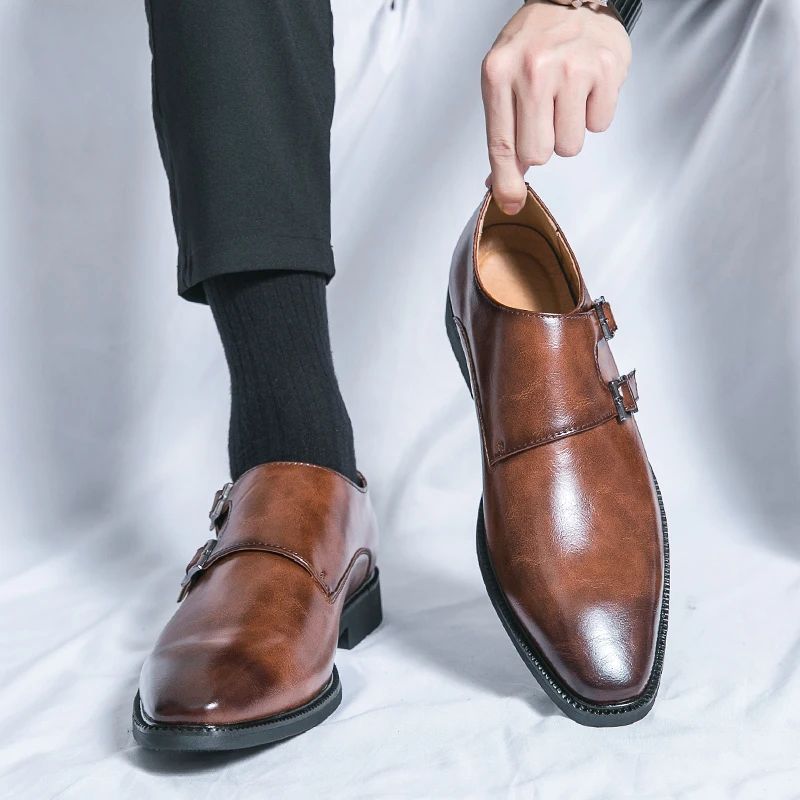
Traditional loafers offer remarkable styling versatility that spans from boardroom-appropriate to weekend-casual. Here’s how to maximize their potential across different settings:
Business and Formal Settings
- Pair black or burgundy leather loafers with tailored suits in navy, charcoal, or black
- Combine with wool dress pants and a crisp button-down shirt with or without a blazer
- Style with pencil skirts or tailored dresses for a polished professional look
- Opt for minimal ornamentation (simple penny loafers or subtle horsebit designs) for more conservative environments
Smart Casual Combinations
- Wear with chinos or wool blend pants and a quality knit top
- Style with dark-wash jeans, a tucked blouse, and a structured blazer
- Pair with midi skirts and a simple sweater for effortless elegance
- Choose rich brown or navy loafers to maximize versatility in this category
Casual Interpretations
- Combine with straight-leg or boyfriend jeans and a simple t-shirt or casual button-down
- Style with cropped pants or rolled cuffs to showcase the shoe
- Wear with casual dresses or skirts for an elevated weekend look
- Select suede versions in versatile colors like tan or soft gray for the most casual flexibility
Sock Strategy
- For formal settings: Choose thin, high-quality socks in colors that complement your pants
- For smart casual: Consider patterned socks that add personality while maintaining sophistication
- For warm weather: No-show socks provide comfort without changing the visual impact
- For a preppy look: Embrace the traditional aesthetic with visible socks in complementary colors
Traditional loafers adapt beautifully across seasons with minimal adjustments—transition from bare ankles in summer to trouser socks in winter without sacrificing style or appropriateness. The key to successful traditional loafer styling lies in considering the overall formality balance of your outfit and allowing these versatile shoes to either elevate casual pieces or relax more formal ones.
Styling Guide: Making Open-Back Loafers Work for You
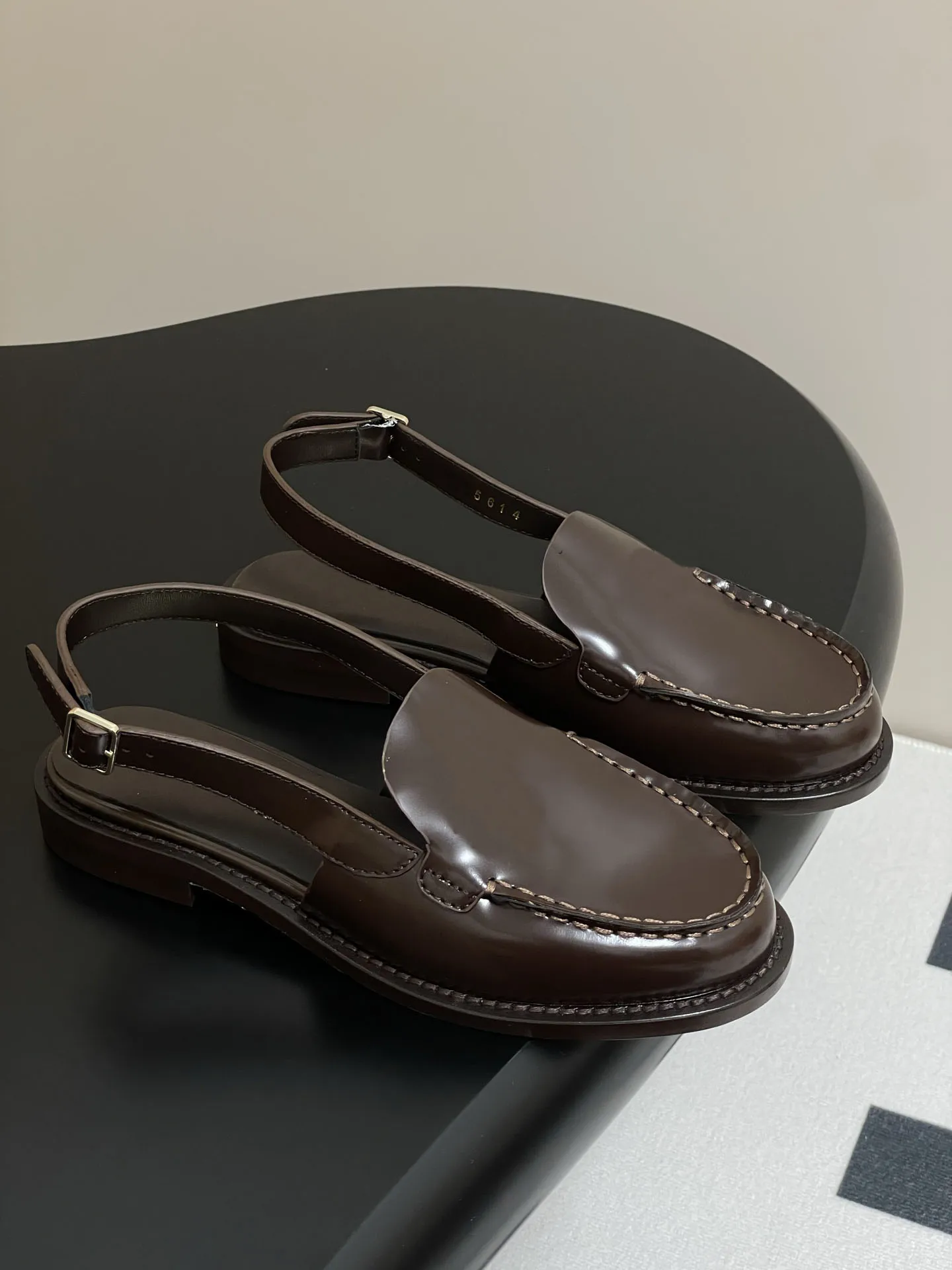
Open-back loafers project a more relaxed, contemporary aesthetic that works beautifully in casual and creative settings. Here’s how to style them effectively:
Casual Chic Approaches
- Pair with ankle-length or cropped straight-leg jeans for a clean, modern look
- Style with paper-bag waist pants or cropped wide-leg styles to highlight the shoe
- Combine with casual linen pants and a simple t-shirt for effortless summer style
- Add rolled cuffs to pants to create visual interest at the ankle area
Dress and Skirt Pairings
- Wear with midi-length dresses or skirts for balanced proportions
- Style with mini skirts and bare legs during warmer months for a youthful look
- Combine with A-line or flowy dresses for a feminine contrast to the structured shoe front
- Layer with lightweight dresses and an oversized cardigan for transitional weather
Elevated Casual Ensembles
- Pair with premium denim and a tucked silk blouse for dinner out
- Style with tailored shorts and a lightweight blazer for smart summer gatherings
- Combine with casual jumpsuits for an effortless one-piece outfit solution
- Add to monochromatic outfits in neutral tones for sophisticated casual appeal
Material and Color Selection
- Black leather versions offer maximum versatility for slightly dressier occasions
- Tan or cognac suede creates a softer look perfect for daytime casual wear
- Embellished versions with hardware or tassels add interest to simple outfits
- Colorful options make excellent statement pieces when paired with neutral clothing
For seasonal styling inspiration, our guide to slingback loafers summer style offers additional ideas for warm-weather outfits featuring open-back designs.
While open-back loafers generally don’t work with visible socks, they can be paired with ultra-thin no-show options in cooler weather if needed. The beauty of these shoes lies in their effortless slip-on convenience combined with the refined appearance of the loafer front—creating a perfect balance between polish and ease.
Practical Decision Guide: Finding Your Perfect Loafer
Choosing between traditional and open-back loafers ultimately comes down to understanding your personal needs, lifestyle demands, and style preferences. Consider these key factors when making your decision:
Lifestyle Assessment
- Professional Requirements: If you work in a business or formal setting several days per week, traditional loafers likely offer greater versatility and appropriateness
- Daily Activities: Consider how much walking or standing your typical day involves—traditional loafers generally provide better support for extended activity
- Convenience Priority: If quick on/off is particularly valuable (parents, frequent travelers), open-back styles offer significant advantages
Comfort Considerations
- Foot Sensitivity: Those with heel sensitivity might prefer open-back designs that eliminate pressure points
- Support Needs: People requiring more structure and stability will typically benefit from traditional designs
- Temperature Factors: Hot weather dominates your climate? Open-back styles offer superior breathability
Style Alignment
Ask yourself these questions:
– Do you tend toward classic, timeless fashion or prefer contemporary, trend-forward looks?
– Are your outfits typically more formal and structured or casual and relaxed?
– Do you value versatility across multiple settings or specialized performance in specific contexts?
Women's Comfortable Flat Loafers, Women's Leopard Print Loafers, Women's Low Heel Loafers
$82.50 Select options This product has multiple variants. The options may be chosen on the product pageWomen's Block Heel Loafers, Women's Heeled Penny Loafers, Women's Monk Strap Loafers
$194.04 Select options This product has multiple variants. The options may be chosen on the product pageWomen's Block Heel Loafers, Women's Square Heel Loafers, Women's Square Toe Flat Loafers
Price range: $73.61 through $86.41 Select options This product has multiple variants. The options may be chosen on the product pageWomen's Comfortable Flat Loafers, Women's Leather Flat Loafers, Women's Round Toe Flat Loafers
$124.88 Select options This product has multiple variants. The options may be chosen on the product pageWomen's Black Flat Loafers, Women's Black Penny Loafers, Women's Classic Tassel Loafers
$194.28 Select options This product has multiple variants. The options may be chosen on the product pageWomen's Loafer Mules, Women's Suede Flat Loafers
$190.23 Select options This product has multiple variants. The options may be chosen on the product page
Climate Considerations
- Seasonal Range: Consider your local climate and how many months would be appropriate for each style
- Indoor/Outdoor Balance: Those who spend most time in climate-controlled environments have more flexibility
- Precipitation Patterns: Frequent rain or snow strongly favors traditional enclosed designs
Decision Checklist
✓ Which style aligns better with my most frequent outfit types?
✓ How important is all-day comfort and support in my typical activities?
✓ Do I prioritize classic versatility or contemporary style?
✓ Which weather conditions do I most often navigate?
✓ Am I looking for maximum occasions of wear or specialized performance?
By honestly evaluating these factors, you can determine which loafer style better serves your specific needs and preferences—or whether having both provides the optimal solution.
Care and Longevity: Maintaining Your Loafers
Proper maintenance significantly extends the life of quality loafers, regardless of which style you choose. Each design has specific care considerations to maximize durability and appearance.
Traditional Loafers Care
- Regular Cleaning: Wipe with a soft cloth after each wear to remove dust and prevent buildup
- Material-Specific Care:
- Leather: Clean with quality leather cleaner, condition 2-4 times yearly
- Suede: Brush regularly with a suede brush, use protective spray
- Patent: Wipe clean with a damp cloth, polish with specific patent cleaner
- Storage Essentials: Insert cedar shoe trees to maintain shape and absorb moisture
- Rotation Practice: Avoid wearing the same pair consecutive days to allow proper drying
- Preventative Measures: Consider adding rubber sole protectors to extend wear
- Professional Care: Have quality pairs resoled when needed rather than replacing
Open-Back Loafers Care
- Edge Protection: Apply edge dressing or conditioner to the exposed back edge to prevent drying and cracking
- Interior Maintenance: Clean insoles regularly with appropriate cleaner to prevent odor buildup
- Careful Storage: Store with the vamp supported to prevent folding or creasing
- Shape Preservation: Use appropriately sized shoe trees that support the front portion
- Surface Treatment: Apply appropriate protectors based on material (water repellent for suede, conditioner for leather)
- Reinforcement Options: Consider adding heel taps if the sole shows premature wear
Quality loafers from reputable manufacturers like Artisan Haul are designed to last for years with proper care. The investment in proper maintenance supplies and occasional professional service pays dividends through extended wear and sustained appearance.
Remember that both styles benefit from regular cleaning and appropriate storage when not in use. Protecting your loafers from extreme temperatures, direct sunlight, and moisture will significantly extend their lifespan regardless of design.
When to Consider Both: Building a Versatile Footwear Collection
Rather than viewing traditional and open-back loafers as competing options, consider how they might complement each other in a well-rounded wardrobe. Many fashion enthusiasts find value in owning both styles for different occasions and seasons.
Complementary Benefits
Traditional loafers provide the versatility and support needed for professional settings and extended wear, while open-back versions offer convenience and breathability for casual scenarios. Together, they cover nearly all footwear needs across the casual-to-business spectrum.
Strategic Selection
When building a collection that includes both styles:
– Choose contrasting colors or materials to maximize versatility
– Select a traditional pair in a conservative style for maximum formal range
– Add an open-back option with distinctive details for casual statement appeal
– Consider seasonal materials—perhaps leather traditional loafers and suede open-backs
Investment Approach
If starting from scratch, most wardrobe experts recommend investing in traditional loafers first, as they offer greater versatility across settings. Once this foundation piece is established, adding an open-back style provides expanded options for casual and warm-weather occasions.
The beauty of a thoughtfully curated collection is that it allows you to select the perfect shoe for each specific occasion rather than forcing one style to serve all purposes. This approach ultimately extends the life of each pair while ensuring you’re always appropriately dressed.
Is Comfort or Style More Important? Finding Your Balance
The perceived trade-off between comfort and style represents a false dichotomy when it comes to quality loafers. The best designs—whether traditional or open-back—successfully merge both considerations rather than sacrificing one for the other.
Beyond the Binary
Both traditional and open-back loafers can offer comfort and style in different ways:
– Traditional loafers provide the comfort of security and support
– Open-back designs offer the comfort of breathability and convenience
– Both can deliver sophisticated style through quality materials and craftsmanship
The key lies in finding well-made versions that prioritize both elements rather than compromising either. Quality matters significantly more than style category when it comes to achieving this balance.
Personal Prioritization
Consider these reflection questions to clarify your personal balance:
– Do you value the comfort of security or the comfort of freedom more in your footwear?
– Is your style primarily classic and refined or contemporary and relaxed?
– Do you prioritize versatility across many settings or specialized performance in specific contexts?
Quality loafers from respected manufacturers like Artisan Haul are designed with both comfort and style in mind, using anatomical knowledge, premium materials, and thoughtful construction to create shoes that feel as good as they look.
Final Thoughts: Making Your Choice with Confidence
Traditional and open-back loafers each offer distinct advantages that appeal to different priorities and lifestyles. Traditional designs excel in versatility, support, and timeless appeal, while open-back versions offer convenience, breathability, and contemporary style.
Your ideal choice depends on your specific needs:
– Professional requirements and formality expectations
– Comfort priorities and support needs
– Personal style aesthetic and wardrobe compatibility
– Climate considerations and seasonal patterns
Quality matters enormously regardless of which style you select. Well-crafted loafers in either design will provide superior comfort, appearance, and longevity compared to poorly made alternatives. Premium materials and thoughtful construction translate directly to enhanced wearing experience and sustained satisfaction.
Many fashion enthusiasts ultimately find that both styles serve valuable roles in a complete wardrobe—traditional loafers for business and extended wear scenarios, open-back designs for casual convenience and warm-weather comfort.
Whichever you choose, investing in quality loafers represents a wardrobe decision you’re unlikely to regret. These versatile shoes continue to evolve while maintaining their fundamental appeal, making them true fashion classics in either their traditional or contemporary expressions.

